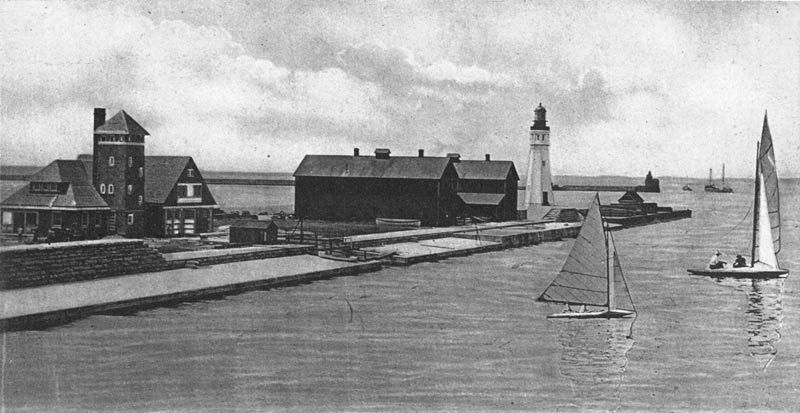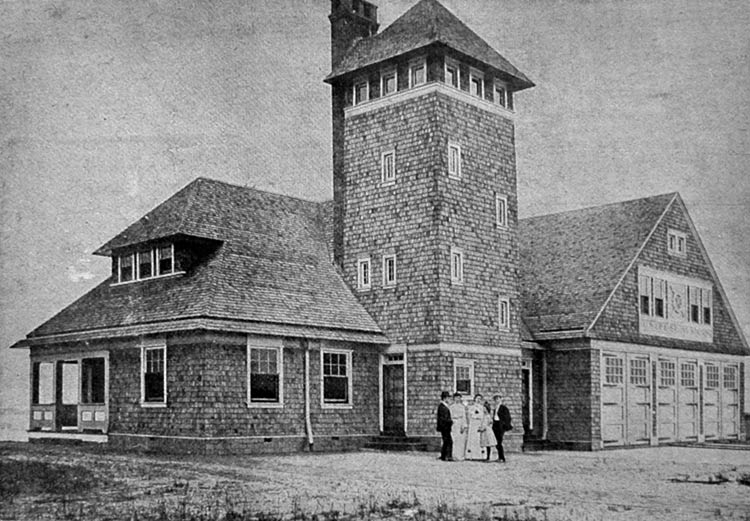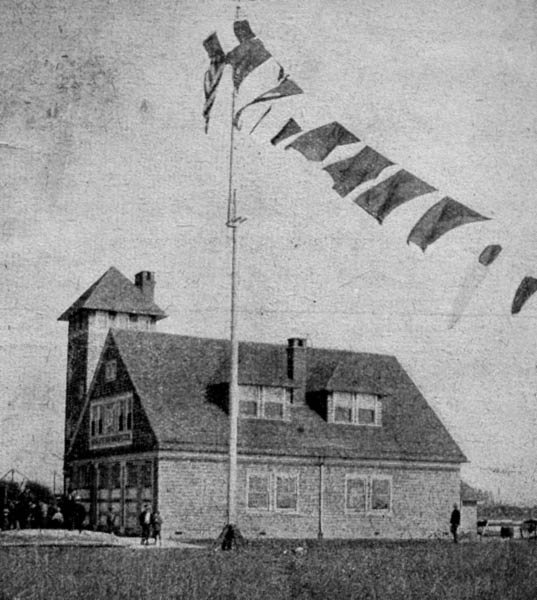
The United States Lifesaving Service, a federal entity, came into existence in 1848, but came to the Great Lakes in 1876 with eleven stations on Lakes Erie, Ontario, and Huron.(By 1914, there would be sixty-two stations on the Great Lakes.) The USLSS in Buffalo initially had a paid station keeper with six surfmen who worked from September 1st through May 31 except during the months when navigation was closed for the winter season. (The Volunteer Lifesaving Corps, on the other hand, operated only during the summer months from a number of locations around Buffalo and exisited to provide for the safety of boaters and swimmers.It was entirely local and not affiliated with the federal agency.)
Called "Soldiers of the Surf" and "Storm Warriors." the job of the USLSS was to launch small boats to rescue people shipwrecked close to shore.

The new lifesaving station under construction winter 1903. Image source:Buffalo & Erie County Public Library
The first ULSS station in Buffalo was in a building formerly occupied by the Lifesaving volunteers. Beginning in 1903, a new station was constructed 600 feet farther along on the South Pier, nearer the lighthouse. New seawall had to be laid to create land enough for the station. Of the $20,000 construction cost, half went to the foundation. The new station would feature a ramp for launching a lifeboat directly into the harbor and a new lookout tower farther away from the Lackawanna Railroad's coal trestle and the obscuring smoke of vessels.

The end of the South Pier after the new Lifesaving Station was finished, 1903. Image source: private collection.

The new lifesaving station, 1903. Image source: Buffalo & Erie County Public Library
The new lifesaving station was constructed of wood, featuring a first floor of "polished hardwood" working space and living quarters on the second floor. The keeper and his family had four rooms to themselves; the crew of eight had a lounge and eight apartments with hot and cold running water. Above the second floor was " a commodious garret."

Another View of new station, 1903. Image source: Buffalo & Erie County Library
The station had two lifeboats (1 of British design, 1 American), each capable of carrying 30 or 40 persons. It also had two smaller surfboats. Often when passengers on a private boat or yacht had to be rescued, they were taken to the station and clothed in dry clothes supplied to every station by the Women's National Relief Association.
View a slideshow of regular training exercises at the Buffalo Life Saving Station, c 1903. Buffalo Express images from the Buffalo & Erie County Library.
Qualifications for surfmen included 3-5 years' experience as a sailor or fisherman. They could not be less than 5' 6" or weigh less than 135 lbs. They had to be excellent swimmers. The work was not year-round, but each season last year's crew usually returned to paid service. The work was monotonous, but appealing to those who loved the water and the risk. "Once a lifesaver, always a lifesaver." By 1899, keepers were paid $900 per year, surfmen $60 per month.
Buffalo native David Porter Dobbins was installed as superiintendent of the 9th District (Buffalo) of the LIfesaving Service in 1876. He developed a lifeboat later named after him. It was lighter than the English lifeboat and quickley became preferred by American and Canadian lifesaving services. The Dobbins Boats were self-bailing, self-righting, with protective chambers at either end for the safe transport of rescued persons. In 1903, Buffalo augmented its complement of boats with a motor lifeboat, 34 feet long. The motor was regarded as auxiliary to the oars and sails.
View a slideshow of Buffalo's lifesaving boats in action, early 1900s. Buffalo Express images from the Buffalo & Erie County Library.

Captain Winslow W. Greisser and his crew, 1903. Image source: Buffalo & Erie County Public Library
Captain Winslow Greisser, aged 37, was appointed keeper of the Buffalo Lifesaving Station in 1901; he had been in the USLSS since age 21. He had also been recently feted for his role in a dramatic rescue during the great gale of November 22, 1900. The job of the lifesaving station keeper included keeping daily journals, providing weekly reports to the superintendent, keeping the equipment in good order., commanding the crew, steering the boat to wrecks and supervising all operations. By law, he was inspector of customs with authority over stranded property and against smuggling. He was responsible for selecting his crew each year, subject to approval of the examining board.
To read a detailed feature about Captain Greisser by Kate Burr in a 1910 issue of the Buffalo Times newspaper, look here. The story also describes the routine at the Lifesaving Station.
Surfman on lookout duty, c. 1910-1920 Image source: Library of Congress
Below is an excerpt about the role of the lookouts of the USLSS is from "The Lifesavers of the Lakes," Buffalo Courier, December 15, 1901
"A rowboat goes out, manned by what is readily seen to be inexperienced persons. He must watch these. Another, perhaps, contains three or four young girls, when, as ignorant as they are light hearted, row recklessly into the swell of tugs and steamers and otherwise court misfortune. These must not escape his eye for a moment. Still another boat passes whose occupants show unmistakable signs of intoxication; these, he is almost certain, will come to grief before they reach the red light. Out on the lakes and in the harbor he sees signs of activity in many of the boats. The ever-present boat rocker is there pursuing his deadly profession; here two people change seats and nearly upset their craft. There a rowboat cuts across the bow of an incoming steamer; a small yacht jibes suddenly and narrowly escapes capsizing, and so one might lengthen the list almost indefinitely.
"It is no wonder that aftger being on duty four hours, the watchmen comes down from the tower with perspiration streaming down his forehead, to throw himself on his bed in an almost exhausted condition. Yet this is an ordinary summer's day's experience."
The USLSS ceased to exist in 1915 when the U.S. Coast Guard was created from the USLSS, the Steamboat Inspection Service, the U.S. Revenue Cutter Service, and the U.S. Lighthouse Service.
The Coast Guard used the Buffalo Lifesaving Service buildings until the early 1950s when they were demolished, the land used by the Coast Guard expanded, and the modern buildings constructed. All that mains is the boat launch.